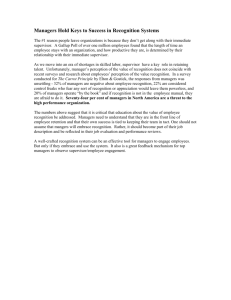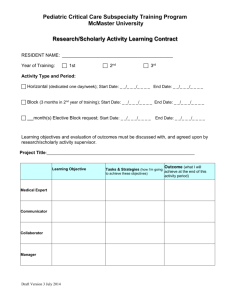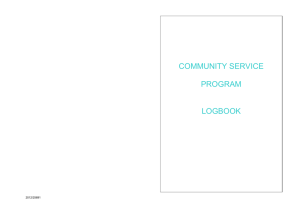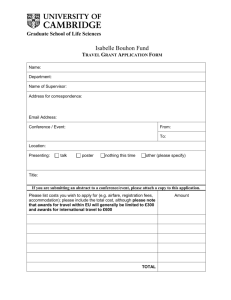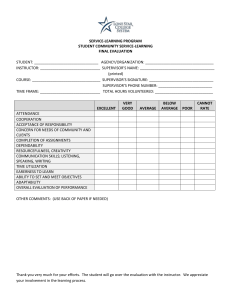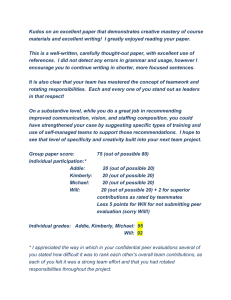G&W Frac-out Mitigation Plan
advertisement
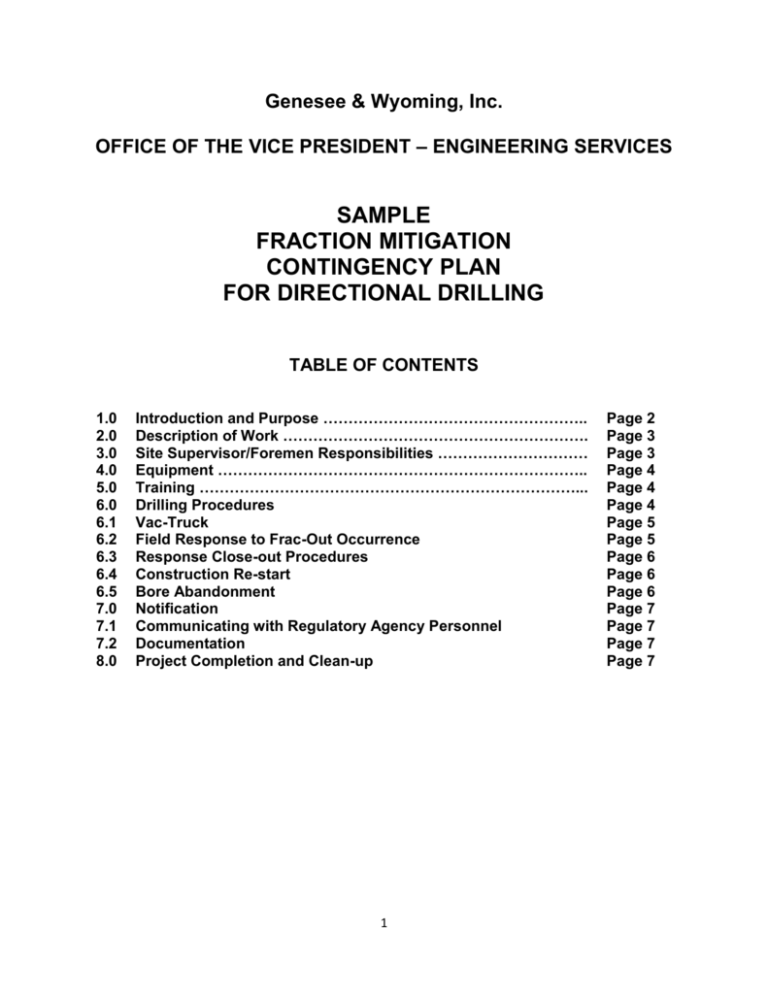
Genesee & Wyoming, Inc. OFFICE OF THE VICE PRESIDENT – ENGINEERING SERVICES SAMPLE FRACTION MITIGATION CONTINGENCY PLAN FOR DIRECTIONAL DRILLING TABLE OF CONTENTS 1.0 2.0 3.0 4.0 5.0 6.0 6.1 6.2 6.3 6.4 6.5 7.0 7.1 7.2 8.0 Introduction and Purpose …………………………………………….. Description of Work ……………………………………………………. Site Supervisor/Foremen Responsibilities ………………………… Equipment ……………………………………………………………….. Training …………………………………………………………………... Drilling Procedures Vac-Truck Field Response to Frac-Out Occurrence Response Close-out Procedures Construction Re-start Bore Abandonment Notification Communicating with Regulatory Agency Personnel Documentation Project Completion and Clean-up 1 Page 2 Page 3 Page 3 Page 4 Page 4 Page 4 Page 5 Page 5 Page 6 Page 6 Page 6 Page 7 Page 7 Page 7 Page 7 FRAC-OUT CONTINGENCY PLAN (FCP) 1.0 Introduction and Purpose Directional bore operations have a potential to release drilling fluids into the surface environment through frac-outs (A frac-out is the condition where drilling mud is released through fractured bedrock into the surrounding rock and sand and travels toward the surface.) Because drilling muds consist largely of a bentonite clay-water mixture, they are not classified as toxic or hazardous substances. However, if it is released into water bodies, bentonite has the potential to adversely impact fish and invertebrates. While drilling fluid seepage associated with a frac-out is most likely to occur near the bore entry and exit points where the drill head is shallow, frac-outs can occur in any location along a directional bore. This Frac-Out Contingency Plan (FCP) establishes operational procedures and responsibilities for the prevention, containment, and cleanup of frac-outs associated with the proposed directional drilling utility project of _________________________________________. All personnel and SubContractors responsible for the work must adhere to this plan during the directional drilling process. The specific objectives of this plan are to: 1. 2. 3. 4. Minimize the potential for a frac-out associated with directional drilling activities; Provide for the timely detection of frac-outs; Protect the environmentally sensitive riverbed and associated riparian vegetation; Ensure an organized, timely, and "minimum-impact" response in the event of a frac-out and release of drilling bentonite; and 5. Ensure that all appropriate notifications are made immediately to the customer, management and safety personnel. 2 2.0 Description of Work: The proposed project consists of: (Explain work task in detail to crew members.) Drilling operations will be halted by the drill rig operators immediately upon detection of a drop in drilling pressure or other evidence of a frac-out. The clean-up of all spills shall begin immediately. Management & safety department shall be notified immediately of any spills and shall be consulted regarding clean-up procedures. A spill kit shall be onsite and used if a fracout occurs. A vacuum truck and containment materials, such as straw bales, shall also be onsite prior to and during all operations. The Site Supervisor will be immediately notified. In the event of a frac-out, the on-site foreman/supervisor will conduct an evaluation of the situation and direct recommended mitigation actions, based on the following guidelines: a. If the frac-out is minor, easily contained. has not reached the surface and is not threatening sensitive resources, drilling operations may resume after use of a leak stopping compound or redirection of the bore; b. If the frac-out has reached the surface, any material contaminated with Bentonite shall be removed by hand to a depth of 2-feet, contained and properly disposed of, as required by law. The drilling contractor shall be responsible for ensuring that the bentonite is either properly disposed of at an approved disposal facility or properly recycled in an approved manner. The Site Supervisor shall notify and take any necessary follow-up response actions in coordination with agency representatives. The Site Supervisor will coordinate the mobilization of equipment stored at off-site locations (e.g., vacuum trucks) on an as needed basis; 3.0 Site Supervisor/Foremen Responsibilities: The Site Supervisor/Foremen has overall responsibility for implementing this FCP. The Site Supervisor/Foremen will ensure that all employees are trained prior to all drilling. The Site Supervisor/Foremen shall be notified immediately when a frac-out is detected. The Site Supervisor/Foremen will be responsible for ensuring that the safety department is aware of the frac-out, coordinating personnel, response, cleanup, regulatory agency notification and coordination to ensure proper clean-up, disposal of recovered material and timely reporting of the incident. The Site Supervisor/Foremen shall ensure all waste materials are properly containerized, labeled, and removed from the site to an approved disposal facility by personnel experienced in the removal, transport and disposal of drilling mud. The Site Supervisor/Foremen shall be familiar with all aspects of the drilling activity, the contents of this Frac-out Contingency Plan and the conditions of approval under which the activity is permitted to take place. The Site Supervisor/Foremen shall have the authority to stop work and commit the resources (personnel and equipment) necessary to implement this plan. The Site Supervisor/Foremen shall assure that a copy of this plan is available (onsite) and accessible to all construction personnel. The Site Supervisor/Foremen shall ensure that all 3 workers are properly trained and familiar with the necessary procedures for response to a fracout, prior to commencement of drilling operations. 4 4.0 Equipment: The Site Supervisor shall ensure that: o All equipment and vehicles are be checked and maintained daily to prevent leaks of hazardous materials; o Spill kits and spill containment materials are available on-site at all times and that the equipment is in good working order; o Equipment required to contain and clean up a frac-out release will either be available at the work site or readily available at an offsite location within 15- minutes of the bore site; and o If equipment is required to be operated near a riverbed, absorbent pads and plastic sheeting for placement beneath motorized equipment shall be used to protect the riverbed from engine fluids; 5.0 Training Prior to the start of construction, the Site Supervisor/Foremen shall ensure that the crew members receive training in the following: o The provisions of the Frac-out Contingency Plan, equipment maintenance and site specific permit and monitoring requirements; o Inspection procedures for release prevention and containment equipment and materials; o Contractor/crew obligation to immediately stop the drilling operation upon first evidence of the occurrence of a frac-out and to immediately report any frac-out releases; o Contractor/crew member responsibilities in the event of a release; o Operation of release prevention and control equipment and the location of release control materials, as necessary and appropriate; and o Protocols for communication with agency representatives who might be on-site during the clean-up effort. 6.0 Drilling Procedures The following procedures shall be followed each day, prior to the start of work. The Frac-out Contingency Plan shall available on-site during all construction. The Site Supervisor/Foremen shall be on-site at any time that drilling is occurring or is planned to occur. The Site Supervisor/Foremen shall ensure that a Job Briefing meeting is held at the start of each day of drilling to review the appropriate procedures to be followed in case of a frac-out. Questions shall be answered and clarification given on any point over which the drilling crew or other project staff has concerns. Drilling pressures shall be closely monitored so they do not exceed those needed to penetrate the formation. Pressure levels shall be monitored randomly by the operator. Pressure levels shall be set at a minimum level to prevent frac-outs. During the pilot bore, maintain the drilled annulus. Cutters and reamers will be pulled back into previously-drilled sections after each new joint of pipe is added. 5 Exit and entry pits shall be enclosed by silt fences a nd straw. A spill kit shall be on-site and used if a frac-out occurs. A vacuum truck shall be readily available on-site prior to and during all drilling operations. Containment materials (Straw, silt fencing, sand bags, frac-out spill kits, etc.) shall be staged on-site at location where they are readily available and easily mobilized for immediate use in the event of an accidental release of drilling mud (frac-out). If necessary, barriers (straw bales or sedimentation fences) between the bore site and the edge of the water source shall be constructed, prior to drilling, to prevent released bentonite material from reaching the water. Once the drill rig is in place, and drilling begins, the drill operator shall stop work whenever the pressure in the drill rig drops, or there is a lack of returns in the entrance pit. At this time the Site Supervisor/Foremen shall be informed of the potential frac-out. The Site Supervisor/Foremen and the drill rig operator(s) shall work to coordinate the likely location of the frac-out. The location of the frac-out shall be recorded and notes made on the location and measures taken to address the concern. The following subsections shall be adhered to when addressing a frac-out situation. Water containing mud, silt, bentonite, or other pollutants from equipment washing or other activities, shall not be allowed to enter a lake, flowing stream or any other water source. The Bentonite used in the drilling process shall be either disposed of at an approved disposal facility or recycled in an approved manner. Other construction materials and wastes shall be recycled, or disposed of, as appropriate. 6.1 Vac-Truck: A vacuum truck shall be staged at a location from which it can be mobilized and relocated so that any place along the drill shot, can be reached by the apparatus, within 10 minutes of a frac-out. 6.2 Field Response to Frac-out Occurrence: The response of the field crew to a frac-out release shall be immediate and in accordance with procedures identified in this Plan. All appropriate emergency actions that do not pose additional threats to sensitive resources will be taken, as follows: a. Directional boring will stop immediately; b. The bore stem will be pulled back to relieve pressure on frac-out; c. The Site Supervisor/Foremen will be notified to ensure that management and the safety department is notified, adequate response actions are taken and notifications made; d. The Site Supervisor/Foremen shall evaluate the situation and recommend the type and level of response warranted, including the level of notification required; e. If the frac-out is minor, easily contained, has not reached the surface and is not threatening sensitive resources, a leak stopping compound shall be used to block the frac-out. If the use of leak stopping compound is not fully successful, the bore stem shall be redirected to a new location along the desired drill path where a frac-out has not occurred; 6 f. If the frac-out has reached the surface, any material contaminated with Bentonite shall be removed by hand, to a depth of 2-feet, contained and properly disposed of, as required by law. A dike or berm may be constructed around the frac-out to entrap released drilling fluid, if necessary. Clean sand shall be placed and the area returned to pre-project contours; and g. If a frac-out occurs, reaches the surface and becomes widespread, the Site Supervisor/Foremen shall authorize a readily accessible vacuum truck and bulldozer stored off-site to be mobilized. The vacuum truck may be either positioned at either end of the line of the drill so that the frac-out can be reached by crews on foot, or may be pulled by a bulldozer, so that contaminated soils can be vacuumed up. 6.3 Response Close-out Procedures: When the release has been contained and cleaned up, response closeout activities will be conducted at the direction of the Site Supervisor/Foremen and shall include the following: a. The recovered drilling fluid will either be recycled or hauled to an approved facility for disposal. No recovered drilling fluids will be discharged into streams, storm drains or any other water source; b. All frac-out excavation and clean-up sites will be returned to pre-project contours using clean fill, as necessary; and c. All containment measures (fiber rolls, straw bale, etc.) will be removed, unless otherwise specified by the Site Supervisor/Foremen. 6.4 Construction Re-start: For small releases not requiring external notification, drilling may continue, if 100 percent containment is achieved through the use of a leak stopping compound or redirection of the bore and the clean-up crew remains at the frac-out location throughout the construction period. For releases requiring external notification and/or other agencies, construction activities will not restart without prior approval from the safety department. 6.5 Bore Abandonment: Abandonment of the bore will only be required when all efforts to control the frac-out within the existing directional bore have failed. 7 7.0 Notification: In the event of a Frac-out that reaches a water source, the Site Supervisor/Foremen will notify safety department so they can notify the appropriate resource agencies. All agency notifications will occur within 24 hours and proper documentation will be accomplished in a timely and complete manner. The following information will be provided: 1. 2. 3. 4. 5. 6. 7. 8. 9. Name and telephone number of person reporting; Location of the release; Date and time of release; Type and quantity, estimated size of release; How the release occurred; The type of activity that was occurring around the area of the frac-out; Description of any sensitive areas, and their location in relation to the frac-out; Description of the methods used to clean up or secure the site; and Listing of the current permits obtained for the project. 7.1 Communicating with Regulatory Agency Personnel: All employees and subcontractors will adhere to the following protocols when permitting Regulatory Agency Personnel arrive on site. Regulatory Agency Personnel will be required to comply with appropriate safety rules. Only the Site Supervisor/Foremen and the safety department are to coordinate communication with Regulatory Agency Personnel. 7.2 Documentation: The Site Supervisor/Foremen shall record the frac-out event in his or her daily log. The log will include the following: Details on the release event, including an estimate of the amount of bentonite released, the location and time of release, the size of the area impacted, and the success of the clean-up action. The log report shall also include the: Name and telephone number of person reporting; Date, How the release occurred; The type of activity that was occurring around the area of the free-out: Description of any sensitive areas, and their location in relation to the frac-out: Description of the methods used to clean up or secure the site; and a listing of the current permits obtained for the project. 8.0 Project Completion and Clean-up: a. All materials and any rubbish-construction debris shall be removed from the construction zone at the end of each workday; b. Sump pits at bore entry and exits will be filled and returned to natural grade; and c. All protective measures (fiber rolls, straw bale, silt fence, etc.) will be removed unless otherwise specified by the Site Supervisor/Foremen. 8



